The sun is performing its daily party piece as it makes its final approach to the horizon. Tinges of orange and yellow fill a sky dotted with the odd wisp of altostratus. The coastal Victorian town of San Remo is doing a poor impression of the Italian Riviera but in a pandemic world where overseas travel has been made virtually impossible, this is as close as I’m getting to a beach in Sanremo anytime soon.
For a fleeting moment, in the former fishing town that gains its name via Ligurian influence, I can dream of an alternate life of wanderlust. The weather is playing the ultimate game of smoke and mirrors because, despite the gin-clear visibility and lowering sun, it’s bitterly cold. The in-car read out displays 12 degrees, but the wind-chill factor is making me question its legitimacy.
It’s this kind of deception that’s almost unwittingly bestowed upon the Ferrari Portofino. Ironically, the cheapest, ‘entry-level’ Ferrari requires the most work to sell. Its ethos and design brief comes across as contrived to purists; a model born purely out of necessity to lure new money to the brand. A cynic could claim it’s a lifestyle GT for posing instead of a driving tool that burnishes the badge rather than only borrowing from it.
Even the marketing bumf seems to work that little bit too hard to convey its legitimacy. Yet, now with an M designation, or Modificata in Ferrari-speak, there is a new narrative. The story now turns to its dynamic ability as the plot moves away from mere aesthetics and badge hierarchy.
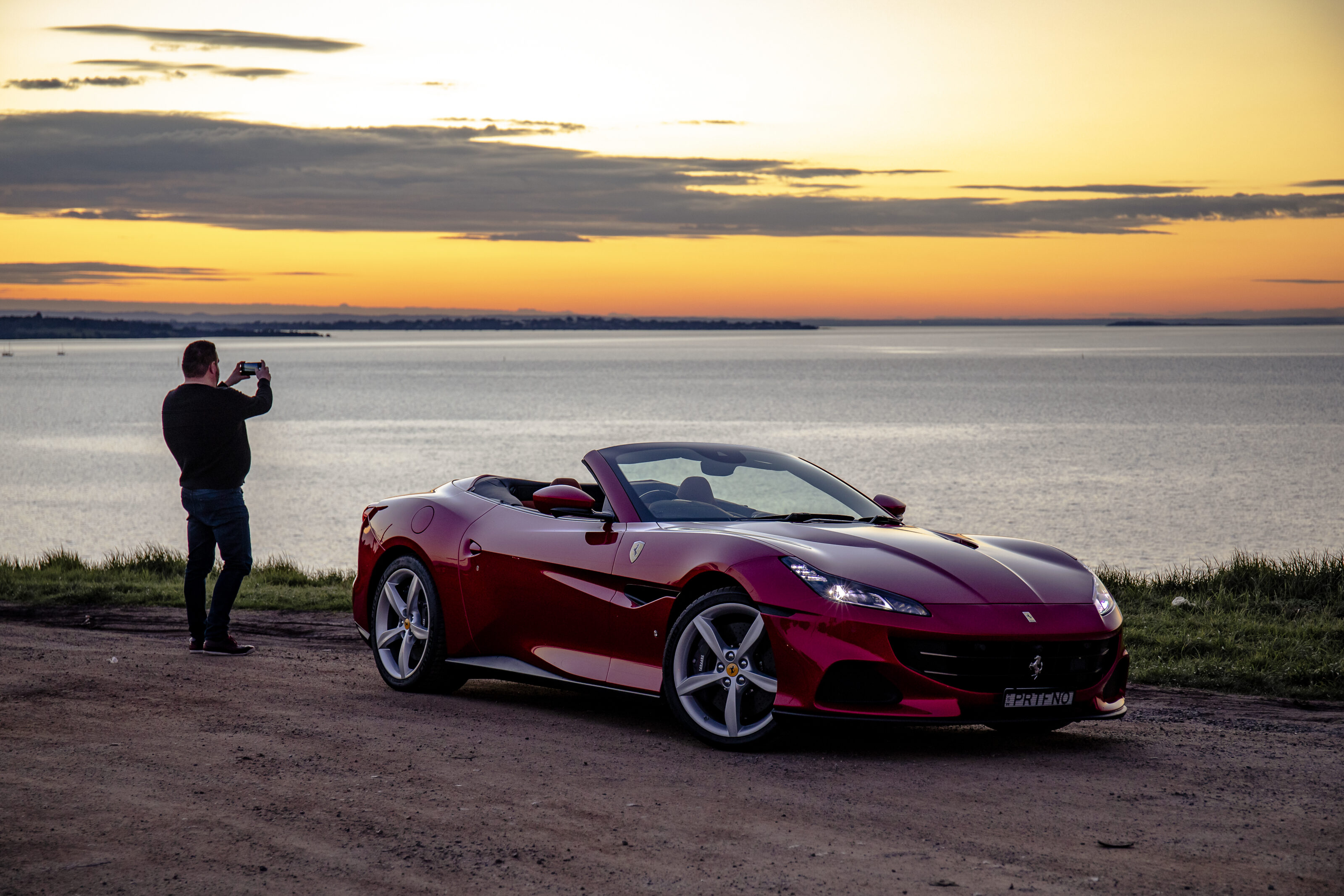
It’s why I find myself, many hours earlier when this road trip starts, trundling along the Bass Highway in single-digit temperatures. I’m in search of the more challenging ribbons of tarmac nestled within west Gippsland.
Cruising at 100km/h, folding hard top in place, I’m staggered by the ride quality. The manettino dial gains two new modes, being Wet and Race, but for now it’s firmly in Comfort. And it’s hard not to question how some luxury manufacturers can’t master the level of bump absorption Ferrari has with its magnetorheological damping.
The addition of Race mode shouldn’t be glossed over. It’s the first time Ferrari has endowed a GT convertible with such focused parameters. The mode allows greater liberties and a newfound aggression from the 3.9-litre twin-turbo V8. The revised F154BE unit now comes in at a heady 456kW and 760Nm thanks to new cam profiles and revised turbochargers.
Yes, you’re reading that right; more than 600 horses for a ‘base’ car. Not that I’m massaging its 7500rpm cut-out, trundling along at 1550rpm. At least I’ve braved the six-degree temperature to drop the roof in. It’s made easier by the optional neck heater that gently wafts hot air through the heated leather seat.
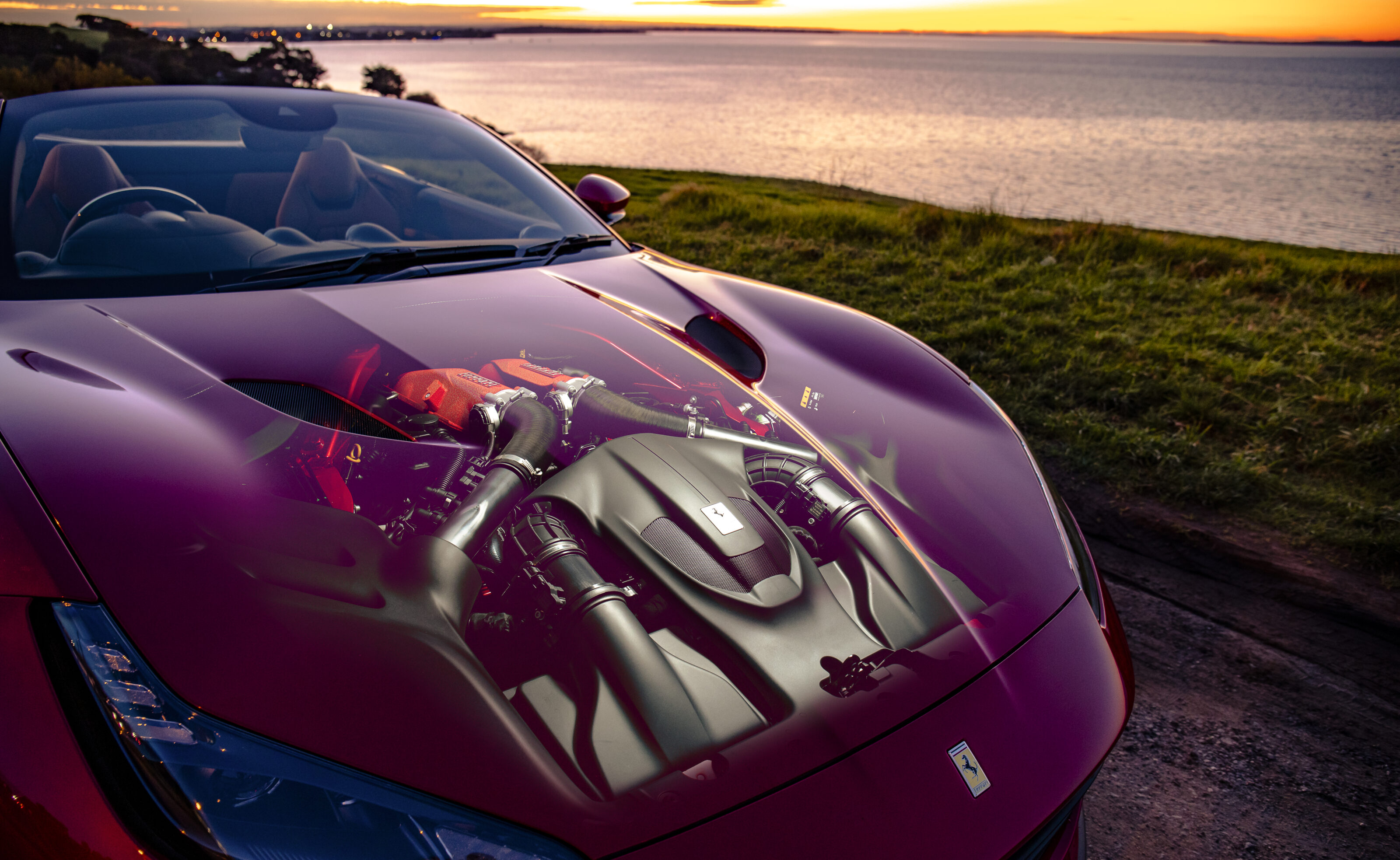
“The revised engine now comes in at a heady 456kw and 760nm … Yes, you’re reading that right; more than 600 horses for a ‘base’ car”
Fuelled and parked at a servo outside Lang Lang, the Rosso Portofino hue – a $22,000 option that’s a shade less overt than Rosso Corsa – suits the car. With the fog lifting faster than the thermometer, the soon-to-be-warming rays bring out the vibrancy in the red, which matches well with the tan-coloured leather innards.
Photographer Ellen Dewar, arrives and promptly states, “I thought it was a convertible” such is the coupe-mimicking cohesiveness when the roof is in place. With a sunset deadline looming and fading winter light a concern, it’s finally time to head off on the 87km route encompassing some of Gippsland’s best, and most challenging, driving roads.
I gallantly agree to keep the roof down. Ellen wants to take advantage of the drop-top’s handsome silhouette. This isn’t a Roma with more headroom and according to Ferrari, it only shares 30 per cent of its structure with the two-door, two-plus-two coupe.
McDonalds Track takes us to Nyora which, somewhat fittingly, is where ABC TV show Something in the Air used to be filmed.
“Turn around, I’ve seen something” radios Ellen. It’s a Pony Club sign. Nice one.

Raw figures are often hard to fathom, yet underfoot, the Portofino M feels every bit as quick as its numbers suggest. Zero to 100km/h takes 3.45 seconds. And for those sticklers for details, you’ll know that’s 0.05sec faster than the usurped model. Attaining 200km/h from rest requires 9.8sec and it’ll go on to more than 320km/h. Quick doesn’t really cover it. The ‘baby’ Fezza has entered a different performance realm.
Tied to a new eight-speed dual-clutch gearbox, which differs from SF90 by having longer ratios and a mechanical reverse gear, it’s rapid-fire. Top gear is for economy, but due to the Variable Boost Management system that feeds in torque through higher gears, traction is a feasible construct. The relentless way in which the Portofino M eviscerates the road ahead is utterly intoxicating.
Yet, it’s not just in a straight line. A short and sweet section of Lang Lang-Poowong Road becomes a winding test bed for the Portofino M’s dynamic wares. It’s filled with twists and turns as well as elevation changes and differing cambers in the road. A third-gear left-hander rises on approach, then plunges at the apex before climbing steeply on exit. It’s rewarding to get right.
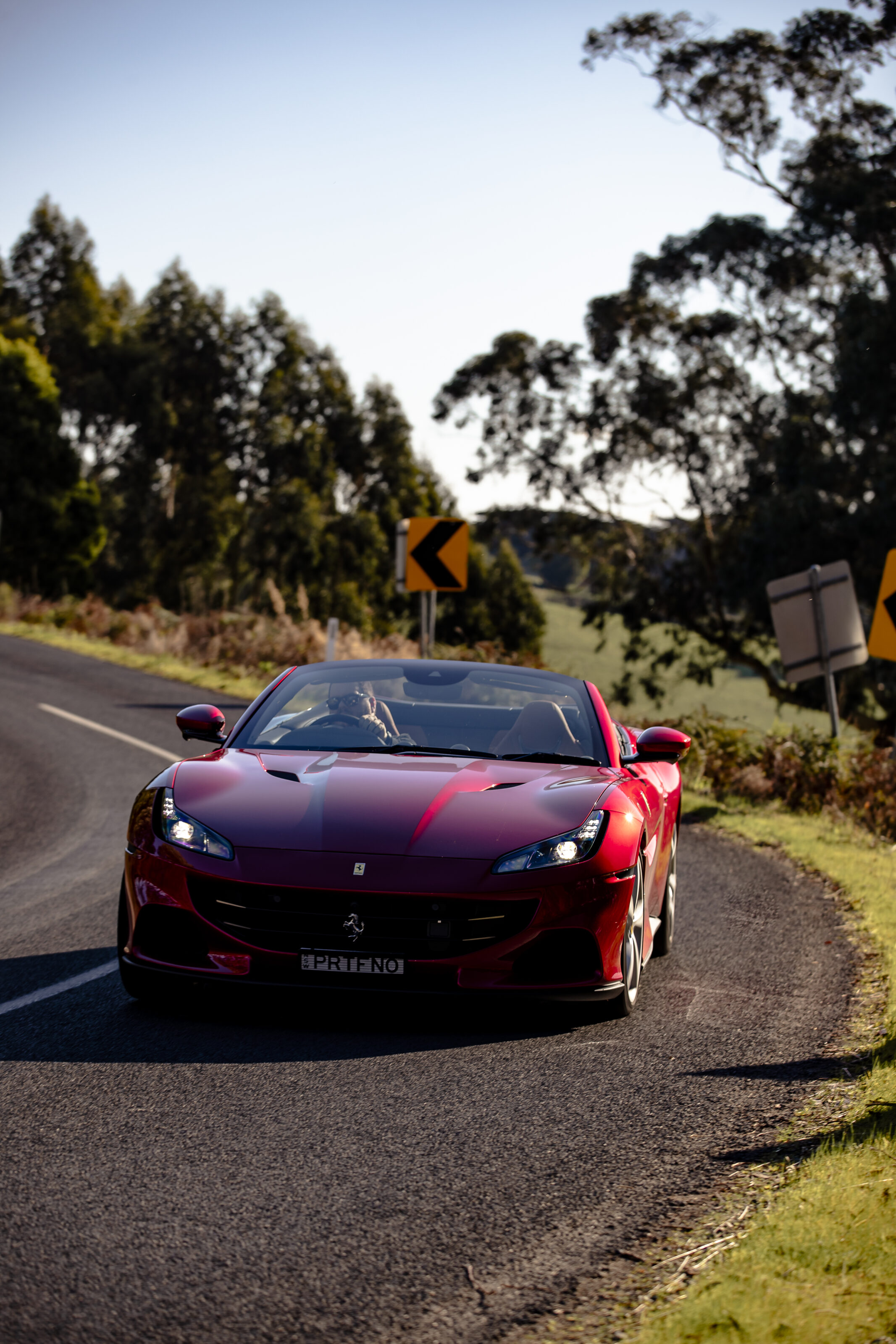
That’s something I don’t accomplish at the first attempt as the super quick steering has me placing the car on a tighter trajectory than the actual apex. That’s rectified with a rapid release of lock, allowing the front 245-section Michelin Pilot Sport 4S tyres to dig in and the chassis to compose itself. My driver error reveals the forgiveness in the platform, one that is long devoid of the scuttle-shake and chassis-flex ills that maligned the California.
Take two. And this time I get it right. The rise is enough to unsettle the Portofino M, yet it naturally uses its travel and with the right amount of lock, the front axle keys into the apex. Fully compressed with downward vertical and lateral forces, the car is being asked a lot of questions. Because of the reactive and light steering, there’s a delicacy required to attain a natural flow through mid corner. From there the rear axle accepts an early throttle application, finding plenty of purchase. The 90-degree, 3855cc boosted V8 blasts the Portofino M up the incline, disdainful of the sweeper it has just conquered.
I think Ellen senses my enjoyment and asks for a few more run-throughs – for photography purposes, of course. Accessing the redline on the centrally mounted tacho seems incongruous with the serenely quiet countryside. Yet, the noise at high revs coerces me to continue breaking the peace. Due to stricter emissions laws the Portofino M now runs a particulate filter. However, Ferrari removed the rear silencers to reduce back pressure and changed the geometry of the entire exhaust (with bypass valves) so that the flat-plane crank V8 retains its voice. When you’re on it, there’s no cause for aural concern.
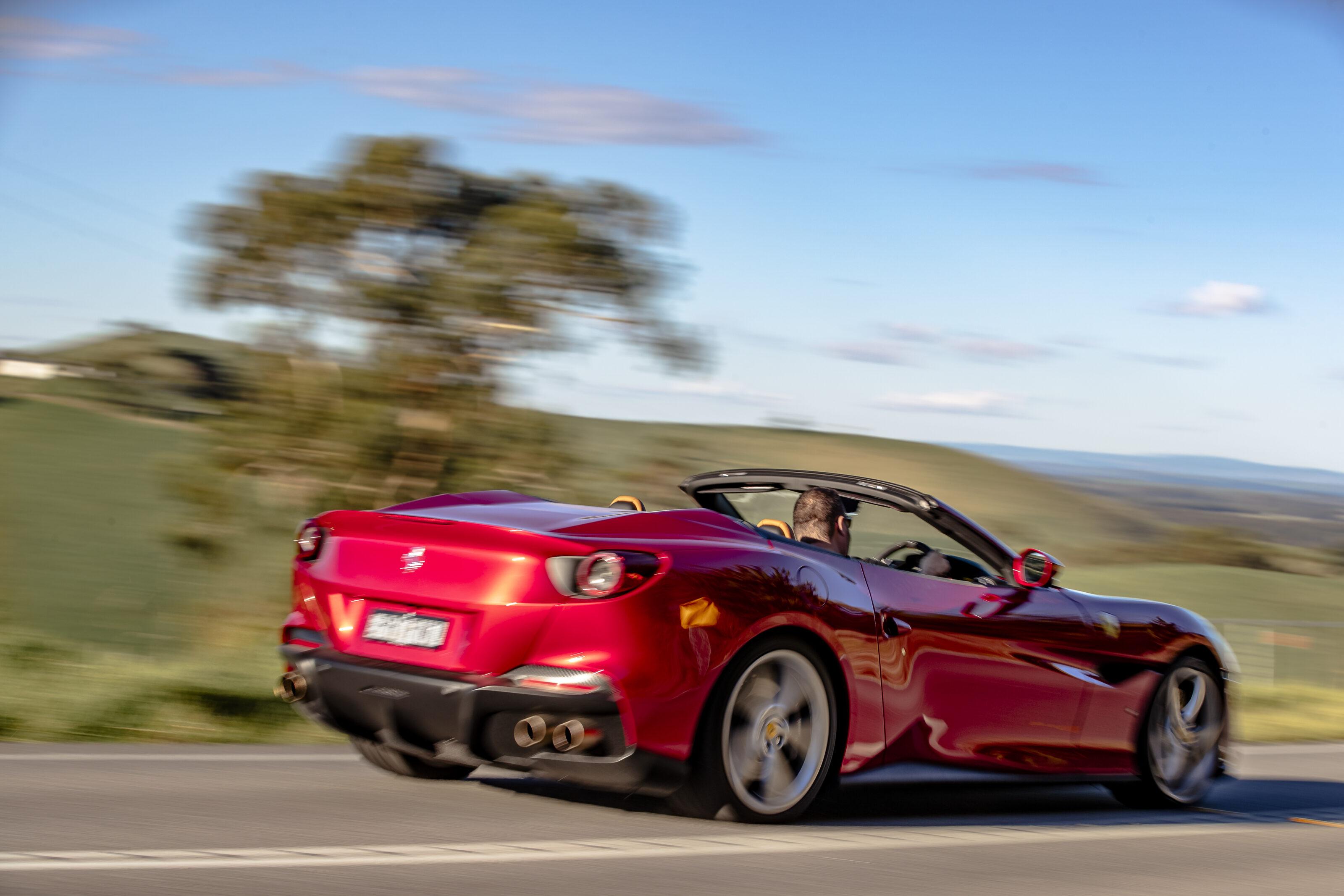
The fact that Poowong recorded 360 residents in the 2016 census isn’t lost on me as I scoff down my peanut butter Vita Wheats – Covid means a packed lunch. I can only imagine the thoughts running through the tradie’s mind parked across the road.
His perplexed facial expressions reminded me that I’m not really the target market for a $438,500 super GT – especially one with an extra $125k in options. But then, with this much performance that can be harnessed, who now really is? Does its bigger brother make it redundant? Or in this fiscal league, do you go the whole hog and buy the $536,888 F8 Tributo Spider? Maybe wait for its 296 successor?
Money is something acutely lacking in country towns. In a time-poor world, highways that now bypass them in the name of traffic efficiency have rendered communities like Bena forgotten pit stops. Blink and you’ll miss it, especially since the South Gippsland Highway bypass rendered it non-essential in 2008. Which is a shame because Bena is quaint. South Road offers up true country scenery and another chance to fully test Ferrari’s Bumpy Road mode – it passes.
Rolling countryside with loads of clear vision is a highlight of this part of Victoria. Fresh air and farm life aplenty, too. The weather is really turning it on now as the temperature almost cracks 20 degrees – which is rare for a Victorian winter. I should be trundling along and leaning into the GT side of the Portofino M. However, Ellen wants ‘spirited movement’ through a 90-degree right-hander for the camera. Okay, if I must…

Arrowing down a straight stretch of Bena-Kongwak Road, I hit the anchors, slapping the left column-mounted paddle as the ’box changes down the ratios with heavy throttle blips. The brake pedal is progressive and offers feel as the calipers clamp down on the standard-fit carbon-ceramic discs.
With all the weight transferring forward, the rear squirms and the car feels alive. Given the front-engine, rear-wheel-drive layout, the Portofino M rotates naturally, and the rear 285-section Michelins allow for plenty of throttle percentage on the way out. By now I’ve built up a working rapport with the M and the manettino dial resolutely remains out of Sport mode. In that mode, it feels too hamstrung by the electronic nannies. A tale that maligned the original Portofino.
It’s not that Race mode needs a warning label yet, as a driver, you do need to be engaged. And it might sound stupid, but for a rear-drive car the Portofino M feels very rear-driven. Under heavy throttle in Race mode, some remedial input is required to stay in a straight line. In corners, this translates to frequent jabs of yaw.
Something I found on Kongwak Road; that moment where an unintentional part-throttle slip requires immediate assessment. With confidence in the car, I decide not to lift as it transitions into a drift. It isn’t a lurid slide, the onlooking cows would have seen better, but it feels almost poetic from behind the wheel.

It’s as if Ferrari now believes the Portofino M isn’t writing dynamic cheques its chassis can’t cash. Proof is found in not only Race mode, but the fact it gains Ferrari’s E-Diff3, Side Slip Control 6.0 (SSC), F1-TCS, SCM-E Frs and the Ferrari Dynamic Enhancer (FDE). This is where the drop-top is at its rawest. The electronics allow freedom to explore the limits of adhesion without totally unshackling the leash. It’s fun with a reassuring safety net.
The road into Kongwak signifies the last of the meaningful corners. And it’d be rude not to enjoy them. Ellen has told me to pull over at a charming old petrol station with the instructions “you can’t miss it”. And I don’t. I’m greeted by the owner who’s popped his head over the fence to see what he’d heard in the distance.
I doubt anything so technologically advanced has ever passed through the garage. His reaction is one of inquisition, moderated by disbelief that a Ferrari is in his forecourt. Taking off he suggests I “have fun”. I chuckle to myself because with daylight running out, I don’t have time to explain how much I already have. Mother Nature’s clock waits for no one.

From there it’s an undulating straight road bombing south to the ocean. The tempo drops and it’s here that my main gripe with the Portofino M is proving hard to shake. At cruising speeds with the roof in place and the dual-clutch box schlepping in eighth gear at 1550rpm, the exhaust drone grates. Badly. It’s not a nice sound and you’ll need to crank up the JBL stereo to drown it out.
Acoustics aside, the straight stretch also gives me an opportunity to fathom the comfort the Portofino provides. The new slim-backed seats are supportive and relaxing, while the material quality has improved throughout the cabin. Okay, it might not feel as vault-like as a Bentley Continental GT Convertible, but the Ferrari also weighs ‘only’ 1664kg.
In an age where minimalist, touchscreen-heavy interiors have become the norm, the Portofino is largely old-school and is festooned with buttons. And you can’t forget the steering wheel, which is wonderfully tactile in hand yet it does away with column-mounted stalks for the turn signals, wipers, and headlights. However, what initially seems an ergonomic nightmare becomes fairly intuitive with familiarity.
The 10.25-inch colour display juggles part of the climate controls as well as the infotainment and smartphone mirroring. An optional 7.0-inch touchscreen also sits before the passenger – so choose them wisely. The back seats are only really there for additional luggage space over the 292-litre boot when the roof is stowed, joyriding young kids being the exception. Sauntering through picturesque Kilcunda it’s hard to imagine ever travelling with more than one person anyway.

Arriving at San Remo causes a stir, as any Ferrari should. Snapper Ellen and I have returned to civilisation and don’t we know it. After a quick clean in what can only be described as a cyclonic car wash it’s straight onto the boardwalk. With some convincing, Ellen allows me to edge the almost $565k cabrio onto the wooden pier.
Idyllically, the San Remo Bridge sits in the background. Built in 1971, it used to be a shoddy, dangerous wooden structure. Now it’s physically sound concrete and forms the gateway to Phillip Island. Or, more importantly, the home of one of Australia’s most picturesque and challenging race tracks. I smile and recognise that some 10 hours ago I’d not have even remotely considered what lap time the Portofino M would achieve. And yet, with the knowledge attained via Gippsland’s tarmac, it now seems a more than reasonable contemplation.
The ‘base’ Ferrari is confident in its identity. The iconic Italian brand wouldn’t endow it with a Race mode and M nomenclature if it didn’t think it has the prowess to back it up. The Portofino M has matured into a proper Prancing Horse with performance credibility and a true duality of talent. It stands in its own shoes with conviction rather than pleading for acceptance. The smoke-and-mirrors factor is now intertwined in an unjust public perception, rather than its DNA. Contrived? Not a chance.
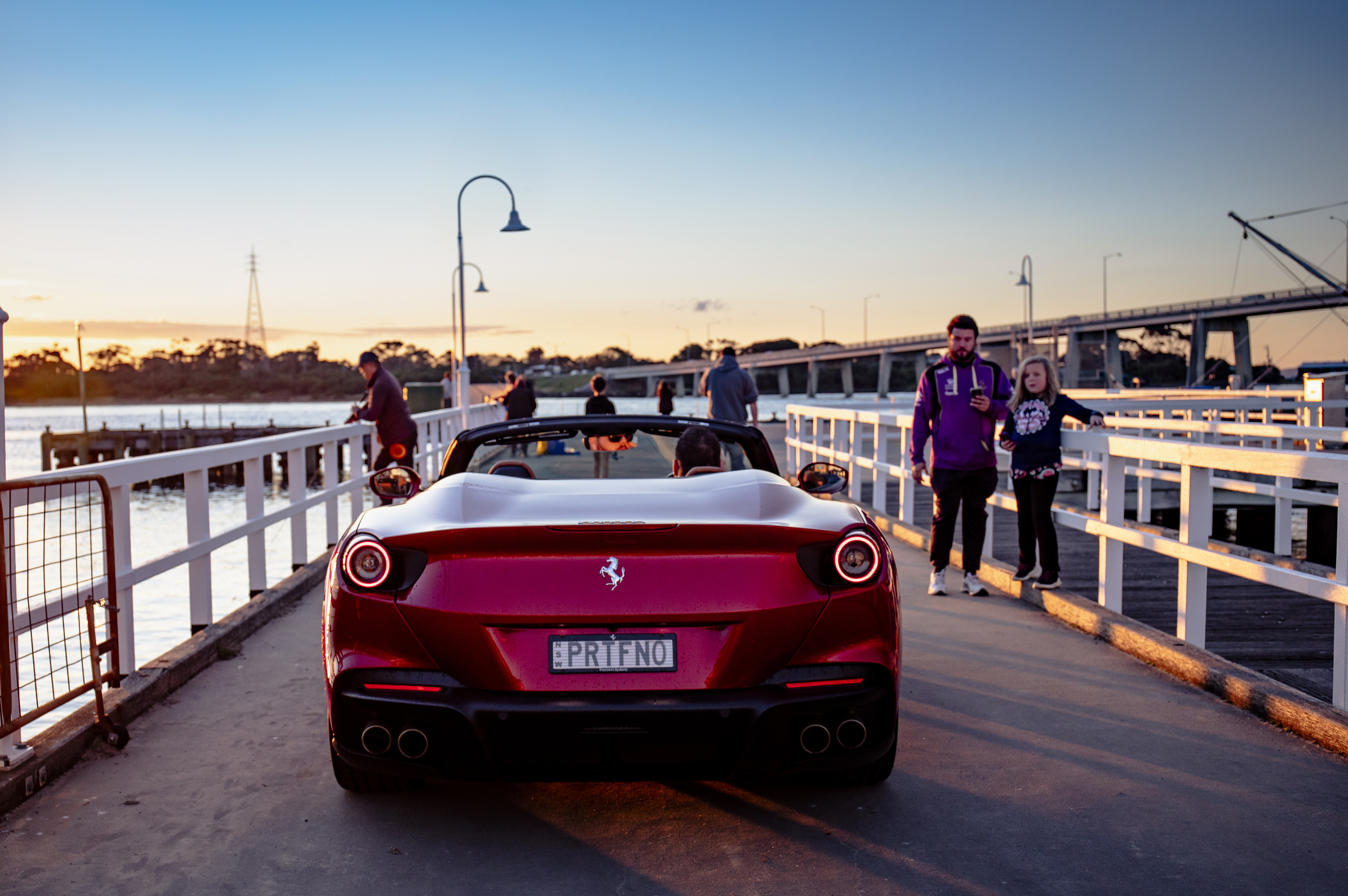
Children don’t care for philosophical musings. And the way in which their eyes open and their smiles widen is proof that the cavallino rampante still has a magic that captivated us when we were their age.
Golden hour in San Remo is fading fast. Ellen is capturing angles like a crazed Italian motorist. And the kids are ignoring the preening pelicans on the beach and snapping pictures of the Ferrari. It’s flamboyant, yet organised chaos. Dad nods approval over his flake and minimum chips. The fact we aren’t on the Italian Riviera couldn’t be starker, but the fanfare is valid. With the Portofino M, the entry-level Ferrari finally deserves its place in the sun.
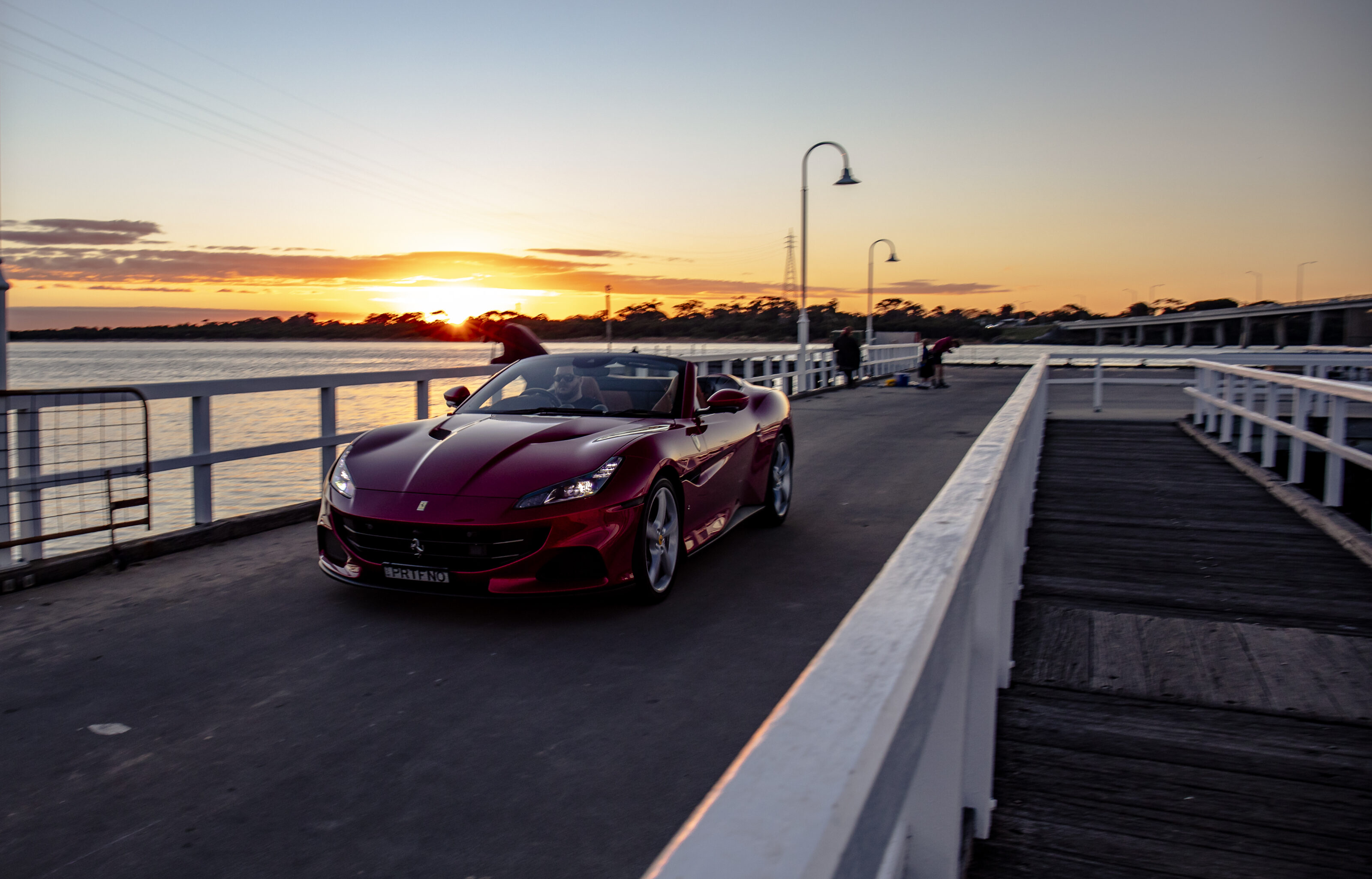
Poowong to San Remo
87 Kilometres
Starting near the ex-Holden proving ground at Lang Lang, there are fuelling options off the Bass Highway. Duck to Loch for a bite to eat and stretch your legs at Cape Horn lookout. End the day with a bevy at the Westernport Hotel in San Remo or with fish and chips by the water.
2021 Ferrari Portofino M specs
| Body | 2-door, 2+2-seat convertible |
|---|---|
| Drive | rear-wheel |
| Engine | 3855cc V8, DOHC, 32v, twin-turbo |
| Bore x Stroke | 86.5 x 82.0mm |
| Compression | 9.45:1 |
| Power | 456kW @ 5750-7500rpm |
| Torque | 760Nm @ 3000-5750rpm |
| Power/Weight | 274kW/tonne |
| Transmission | 8-speed dual-clutch |
| Weight | 1664kg |
| u00a0Suspension | independent double wishbone, coil springs, anti-roll bar, adaptive dampers (f); multi-links, coil springs, adaptive dampers, anti-roll bar (r) |
| L/W/H | 4594/1938/1318mm |
| Wheelbase | 2670mm |
| Tracks | 1633/1635mm (f/r) |
| Steering | electrically assisted rack-and-pinion |
| Brakes | 390mm carbon-ceramic discs, 6-piston calipers (f); 360mm carbon-ceramic discs, 4-piston calipers (r) |
| Wheels | 20.0 x 8.0-inch (f); 20.0 x 10.0-inch (r) |
| Tyres | 245/35 ZR20 (f); 285/35 ZR20 (r) Michelin Pilot Sport 4 S |
| Price | $438,500 ($563,489 as tested) |
| Pros | A u2018properu2019 Ferrari; engine performance; sorted dynamics |
| Cons | Exhaust drone at cruising speeds; expensive options |
We recommend
-
 Features
FeaturesDon’t underestimate the Ferrari Portofino M
It’s time to pay respect to Ferrari’s front-engined convertible
-
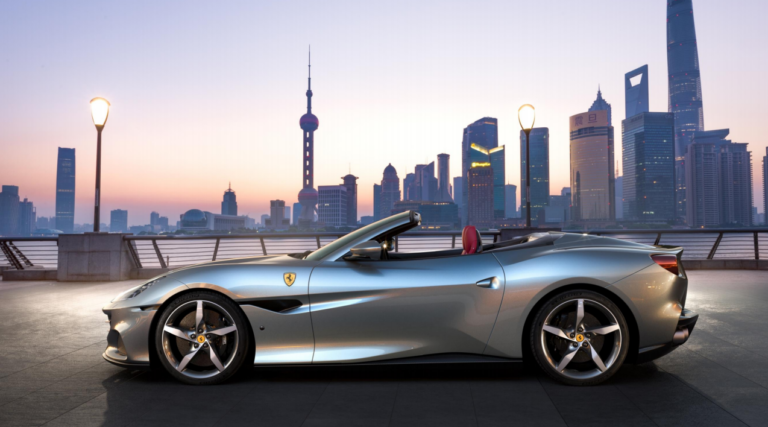 News
NewsFerrari takes a second second stab with the Portofino M
The Portofino M looks to claim back some of the attention stolen by the lovely Ferrari Roma. What does 'modificata' mean this time round?
-
 News
NewsFerrari will continue on with V12s as turbocharged engines
The V12 may have been thrown a lifeline





